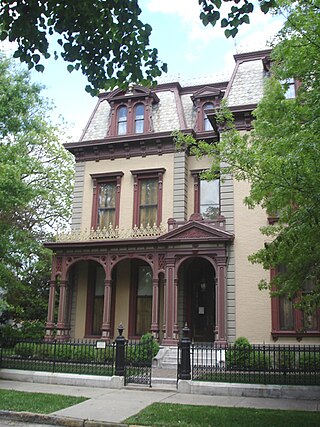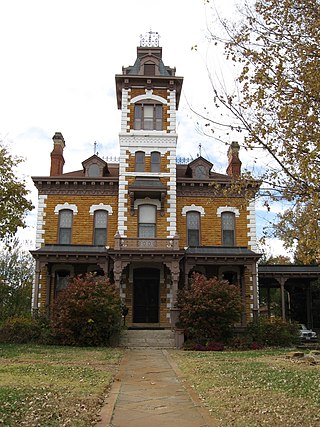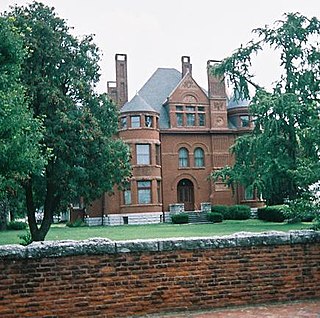
Berkeley Plantation, one of the first plantations in America, comprises about 1,000 acres (400 ha) on the banks of the James River on State Route 5 in Charles City County, Virginia. Berkeley Plantation was originally called Berkeley Hundred, named after the Berkeley Company of England. In 1726, it became the ancestral home of the Harrison family of Virginia, after Benjamin Harrison IV located there and built one of the first three-story brick mansions in Virginia. It is the home to two presidents of the United States: William Henry Harrison, and his grandson Benjamin Harrison. It is now a museum property, open to the public.

Richmond is a city in eastern Wayne County, Indiana, United States. Bordering the state of Ohio, it is the county seat of Wayne County. In the 2020 census, the city had a population of 35,720. Situated largely within Wayne Township, its area includes a non-contiguous portion in nearby Boston Township, where Richmond Municipal Airport is currently located. It is the principal city of the Richmond micropolitan area.

Drumthwacket is the official residence of the governor of New Jersey. The mansion sits at 354 Stockton Street in Princeton, near the state capital of Trenton. It is one of only four official governor's residences in the country not located within their respective state capitals; the others are in Wisconsin, Ohio, and Tennessee.

The White House of the Confederacy is a historic house located in the Court End neighborhood of Richmond, Virginia. Built in 1818, it was the main executive residence of the sole President of the Confederate States of America, Jefferson Davis, from August 1861 until April 1865. It was viewed as the Confederate States counterpart to the White House in Washington, D.C. It currently sits on the campus of Virginia Commonwealth University.

The Reitz Home Museum is a Victorian house museum located in the Riverside Historic District in downtown Evansville, Indiana. The museum offers year-round guided tours.

Lebold Mansion is a Victorian-era house in Abilene, Kansas, United States. Lebold Mansion was added to the National Register of Historic Places in 1973.

Historic Rock Ford, which is also known as the General Edward Hand House, is an historic house in southeastern Lancaster, Pennsylvania. Although the property is surrounded by Lancaster County Central Park, it is privately owned and operated by the Rock Ford Foundation, a 501(c)(3) not-for-profit organization.

The Howard Steamboat Museum, or the Howard National Steamboat Museum, is located in Jeffersonville, Indiana, across from Louisville, Kentucky. House in the Howard Family mansion, it features items related to steamboat history and specifically, the Howard Shipyards of Jeffersonville, IN. The building is listed on the National Register of Historic Places.

The Villa Louis is a National Historic Landmark located on St. Feriole Island, in Prairie du Chien, southwestern Wisconsin. The villa and estate are a historical museum operated by the Wisconsin Historical Society. The site has been restored to its appearance during the late 19th century, when it was the estate of the prominent H. Louis Dousman family, descendants of a fur trader and entrepreneur.

Gaar, Scott & Co., was an American threshing machine and steam traction engine builder founded in 1849 and based in Richmond, Indiana. The company built simple and compound engines in sizes from 10 to 50 horsepower. Farm machinery produced by the firm were advertised as part of "the Tiger Line" and used a tiger upon two globes as the company logo. In the Fall of 1869, A. Gaar & Co. won "Best Portable Farm Steam Engine" and "Best Eight Horse Power" at the 17th Illinois State Fair, for which it won two Silver Medal prizes. It merged with the M. Rumley Co. in 1911 during a purchasing frenzy that put the later firm into insolvency. The company was reorganized as Advance-Rumely Thresher Company Inc. Advance-Rumely Thresher Company was later purchased by Allis-Chalmers Mfg. Co.
The C. H. Moore Homestead, in Clinton, Illinois, is one of two Registered Historic Places in DeWitt County. The other, the Magill House, was added to the Register in 2003. CH Moore Homestead DeWitt County Museum was added in 1979.

The Joseph D. Oliver House, also known as Copshaholm, sits on 808 W. Washington Street, at the corner of Chapin Street in South Bend, Indiana. The mansion was built for the Oliver family, founders of the Oliver Chilled Plow Works, and named after the Scottish village of the patriarch. It is listed on the National Register of Historic Places.
John Adam Hasecoster (1844–1925) was an American architect in Indiana. His practice was located in Richmond, Indiana. He designed public buildings as well as residences in the area, some of which have been listed on the National Register of Historic Places.

Wayne Township is one of fifteen townships in Wayne County, Indiana, United States. As of the 2010 census, its population was 41,217 and it contained 19,510 housing units.

Millford Plantation is a historic forced-labor farm and plantation house located on SC 261 west of Pinewood, South Carolina. It was sometimes called Manning's Folly, because of its remote location in the High Hills of Santee section of the state and its elaborate details. Designated as a National Historic Landmark, it is regarded as one of the finest examples of Greek Revival residential architecture in the United States. The house has been restored and preserved along with many of its original Duncan Phyfe furnishings.

The Rahr–West Art Museum is an art museum in Manitowoc, Wisconsin. It is located in the Joseph Vilas Jr. House, which is listed on the National Register of Historic Places. The house is a significant example of Queen Anne style architecture in the United States.

The Reynolds Metals Company International Headquarters is an International Style building complex set in a composed landscape in Henrico County, near Richmond, Virginia, completed in 1958. The low-rise Executive Office Building was designed by Gordon Bunshaft of Skidmore, Owings and Merrill, in collaboration with Richmond landscape architect Charles F. Gillette. The headquarters complex has been cited as a prototype for modern suburban office development. It was listed on the National Register of Historic Places in 2000. It is the headquarters for the Altria Group, formerly known as the Philip Morris Companies, Inc. The property is owned by the University of Richmond.

Callanwolde Fine Arts Center is a 501(c)(3) non-profit community arts center that offers classes and workshops for all ages in visual, literary and performing arts. Special performances, gallery exhibits, outreach programs and fundraising galas are presented throughout the year. Callanwolde is also involved in community outreach, specializing in senior wellness, special needs, veterans, and low income families.

Rose Terrace was a private home located at 12 Lake Shore Drive in Grosse Pointe Farms, Michigan. Built in 1934 by Anna Dodge, widow of automobile pioneer Horace E. Dodge, it was designated a Michigan State Historic Site in 1971 and listed on the National Register of Historic Places in 1971. Despite this, the house was demolished in 1976.

The William H. Davenport House, also known as the Davenport-Curtis House, is a single-family home located at 300 East Michigan Avenue in Saline, Michigan. It was listed on the National Register of Historic Places in 1975.






















